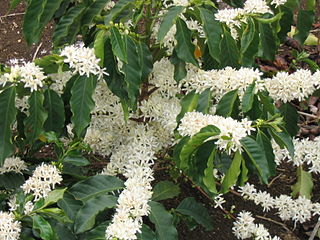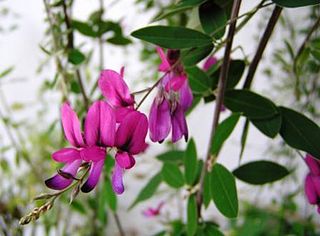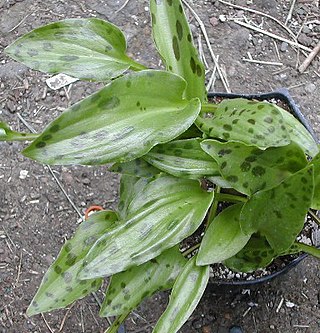
Coffea is a genus of flowering plants in the family Rubiaceae. Coffea species are shrubs or small trees native to tropical and southern Africa and tropical Asia. The seeds of some species, called coffee beans, are used to flavor various beverages and products. The fruits, like the seeds, contain a large amount of caffeine, and have a distinct sweet taste.

Oryza is a genus of plants in the grass family. It includes the major food crop rice. Members of the genus grow as tall, wetland grasses, growing to 1–2 metres (3–7 ft) tall; the genus includes both annual and perennial species.

Dioscorea is a genus of over 600 species of flowering plants in the family Dioscoreaceae, native throughout the tropical and warm temperate regions of the world. The vast majority of the species are tropical, with only a few species extending into temperate climates. It was named by the monk Charles Plumier after the ancient Greek physician and botanist Dioscorides.

Lespedeza is a genus of some 45 species of flowering plants in the pea family (Fabaceae), commonly known as bush clovers or Japanese clovers (hagi). The genus is native to warm temperate to subtropical regions of eastern North America, eastern and southern Asia and Australasia.

Anthocleista is a genus of tree- and shrub-like tropical plants in the subtribe Potaliinae in the Gentian family. There are between 14 and 16 species in the genus, native mainly to tropical Africa, including Madagascar and the Mascarene Islands. Anthocleista was once placed in the family Loganiaceae, but more recent molecular, morphological, and phytochemical evidence has placed the group well within the Gentianaceae.

Manilkara is a genus of trees in the family Sapotaceae. They are widespread in tropical and semitropical locations, in Africa, Madagascar, Asia, Australia, and Latin America, as well as various islands in the Pacific and in the Caribbean. A close relative is the genus Pouteria.

Theobroma is a genus of flowering plants in the mallow family, Malvaceae. It was previously classified as a member of Sterculiaceae, which has been incorporated into Malvaceae to make it monophyletic. It contains roughly 20 species of small understory trees native to the tropical forests of Central and South America.

Desmodium is a genus of plants in the legume family Fabaceae, sometimes called tick-trefoil, tick clover, hitch hikers or beggar lice. There are dozens of species and the delimitation of the genus has shifted much over time. Species are distributed widely – from Quebec to northern Argentina in the Americas, across northern and southern tropical Africa, in the southern Arabian Peninsula, in Myanmar and Thailand, New Guinea, and northern and eastern Australia.

Baptisia, commonly referred to as wild indigo or false indigo, represents a diverse genus within the legume family, Fabaceae. These flowering herbaceous perennials exhibit an array of characteristics, including pea-like flowers, blooming in the spring that eventually mature into pods, occasionally displaying an inflated form. Renowned for their enduring presence and a spectrum of colours ranging from yellow, blue and white, Baptisia's captivate gardeners with their colourful stems, unique foliage, and exquisite flowers.

Brongniartia is a genus of leguminous plants in family Fabaceae. It includes 63 species native to Mexico and Texas and to Bolivia. The genus was first named by Kunth after the French botanist Adolphe Brongniart.

Cryptosepalum is a genus of flowering plants in the family Fabaceae. There are 12 species, mostly trees. They are native to sub-Saharan Africa, ranging from Guinea to Tanzania, Mozambique, and Angola.

Drimiopsis is a genus of African bulbous perennial herbs in the family Asparagaceae, subfamily Scilloideae, native to sub-Saharan Africa. Sometimes species are placed under the genus Ledebouria.
Aningeria is a genus of flowering plants in the family Sapotaceae. The genus includes five species of trees which range across tropical Africa, from Guinea Bissau eastwards to Ethiopia and Kenya, and from South Sudan south to Zimbabwe.
Aphanocalyx is a genus of flowering plants in the family Fabaceae. It belongs to the subfamily Detarioideae. It includes 14 species native to tropical Africa, ranging from Sierra Leone to Côte d'Ivoire, and from Cameroon to Angola and Tanzania.

Uraria is a genus of plants in the legume family, Fabaceae. It includes 24 species of shrubs and subshrubs native to sub-Saharan Africa, the Indian Subcontinent, Indochina, China, Malesia, Papuasia, Australia, and the South Pacific. Typical habitats are seasonally-dry tropical woodland or grassland. It belongs to the subfamily Faboideae and the tribe Desmodieae.

The tribe Desmodieae is one of the subdivisions of the plant family Fabaceae. It is composed of two subtribes, Desmodiinae and Lespedezinae. Recent phylogenetics has this tribe nested within tribe Phaseoleae.

Grona is a genus in the flowering plant family Fabaceae. Its native range is worldwide tropics and subtropics.
Gambeya is a genus of flowering plants belonging to the family Sapotaceae.

Mononeuria is a genus of flowering plants belonging to the family Caryophyllaceae.















